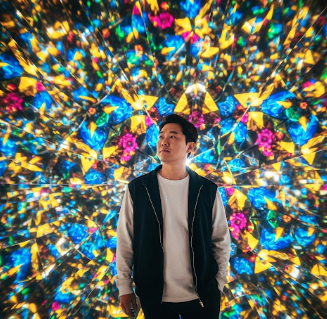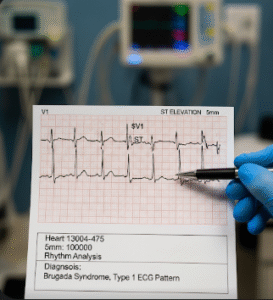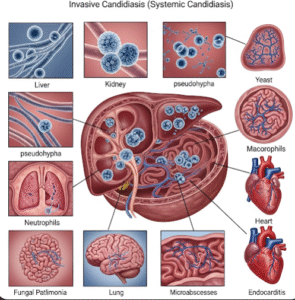Overview
Kaleidoscope vision is a visual disturbance characterized by seeing multi-colored patterns, wavy lines, or fragmented images, often resembling the view through a kaleidoscope. This phenomenon can be temporary or recurrent and may be associated with migraine, eye disorders, or neurological conditions.
In Korea, ophthalmology and neurology clinics provide advanced diagnostic services for kaleidoscope vision, combining eye exams, imaging, and neurological assessments. Understanding the underlying cause is essential for effective management, as it can range from benign migraine auras to more serious neurological issues.
Key Facts
- ➔ Kaleidoscope vision is often a symptom, not a standalone condition.
- ➔ It may affect one or both eyes, temporarily altering visual perception.
- ➔ Common triggers include migraines, eye strain, and retinal disturbances.
- ➔ Symptoms may be accompanied by headache, nausea, or light sensitivity.
- ➔ Prompt evaluation is essential to rule out neurological or ocular disorders.
What is Kaleidoscope Vision?
Kaleidoscope vision refers to the visual perception of fragmented, multicolored patterns, often transient in nature. These patterns can appear as:
- ➔ Wavy, shimmering lines
- ➔ Geometric or fractal shapes
- ➔ Shimmering lights or flashes
- ➔ Distorted or multiplied images
- ➔ Mechanism: The phenomenon can arise from changes in retinal or cortical activity. In migraine auras, hyperexcitability of the visual cortex leads to these visual disturbances.
- ➔ Clinical significance: Although often benign, kaleidoscope vision can sometimes indicate retinal detachment, ocular migraine, or neurological disease, making proper assessment critical.
What Symptoms Are Related To
Kaleidoscope vision can present alongside a variety of symptoms depending on the cause:
- ➔ Visual flashes, scintillations, or zigzag patterns
- ➔ Temporary vision loss or blurred vision
- ➔ Headaches, often unilateral if associated with migraine
- ➔ Nausea or vomiting
- ➔ Light sensitivity (photophobia)
- ➔ Eye strain or discomfort
- ➔ Occasionally dizziness or aura-like sensations
Recognizing these associated symptoms helps clinicians differentiate between benign and pathological causes.
What Causes / Possible Causes
Several conditions may lead to kaleidoscope vision:
- ➔ Ocular migraine (migraine with aura): The most common cause, often accompanied by headache, nausea, or light sensitivity.
- ➔ Retinal disorders: Retinal detachment, retinal tears, or macular degeneration may produce visual distortions.
- ➔ Neurological conditions: Epilepsy, multiple sclerosis, or brain lesions can manifest with visual auras.
- ➔ Eye strain or refractive errors: Overuse of digital screens or uncorrected vision problems.
- ➔ Medication or toxin effects: Certain medications or recreational substances may alter visual perception.
- ➔ Stress and fatigue: Physical or emotional stress can trigger transient visual disturbances.
Determining the underlying cause is essential for selecting appropriate treatment and preventing complications.
When Should I See My Doctor
You should seek medical evaluation if kaleidoscope vision is:
- ➔ Persistent or worsening over time
- ➔ Accompanied by sudden vision loss, floaters, or flashes
- ➔ Associated with severe headache, nausea, or neurological symptoms
- ➔ Following head trauma or injury
- ➔ Occurring with systemic symptoms like dizziness, weakness, or confusion
- ➔ Recurrent and affecting daily functioning
Early assessment helps prevent vision-threatening conditions and ensures timely treatment of underlying disorders.
Care and Treatment
Management of kaleidoscope vision focuses on treating the underlying cause:
- ➔ Migraine management: Preventive medications, acute migraine therapies, and lifestyle modifications.
- ➔ Eye care: Correcting refractive errors, managing retinal or ocular disorders.
- ➔ Neurological evaluation: Imaging (MRI or CT) for suspected brain lesions or neurological disorders.
- ➔ Lifestyle adjustments: Reducing screen time, improving sleep, managing stress, and avoiding triggers.
- ➔ Medications: Pain relievers, anti-nausea agents, or preventive migraine therapies as indicated.
- ➔ Regular monitoring: Periodic eye exams and follow-up with neurologists if recurrent or severe.
With appropriate care, most patients experience significant reduction in visual disturbances and improved quality of life.
Treatment Options in Korea
Korean ophthalmology and neurology centers offer comprehensive evaluation and management for kaleidoscope vision:
- ➔ Eye examination: Comprehensive assessment including fundus examination, retinal imaging, and optical coherence tomography (OCT).
- ➔ Neurological assessment: MRI, CT scans, and EEG for suspected neurological causes.
- ➔ Medication management: Migraine prophylaxis, anti-inflammatory medications, or eye-specific treatments.
- ➔ Laser or surgical interventions: For retinal tears, detachment, or macular degeneration.
- ➔ Multidisciplinary care: Collaboration between ophthalmologists, neurologists, and pain specialists for complex cases.
- ➔ Preventive care: Lifestyle guidance, trigger avoidance, and vision therapy to minimize recurrence.
Top hospitals such as Seoul National University Hospital, Asan Medical Center, and Samsung Medical Center provide state-of-the-art diagnostics and personalized treatment plans for patients with kaleidoscope vision.
In Summary: Kaleidoscope vision is a visual disturbance that can range from benign migraine aura to serious ocular or neurological conditions. Early recognition, accurate diagnosis, and advanced treatment in Korea can prevent complications, restore normal visual perception, and improve quality of life.
- ➔ Key Takeaway: Recurrent or severe kaleidoscope vision should prompt timely medical evaluation.
- ➔ Action Point: Consult an ophthalmologist or neurologist for comprehensive assessment and personalized treatment.













